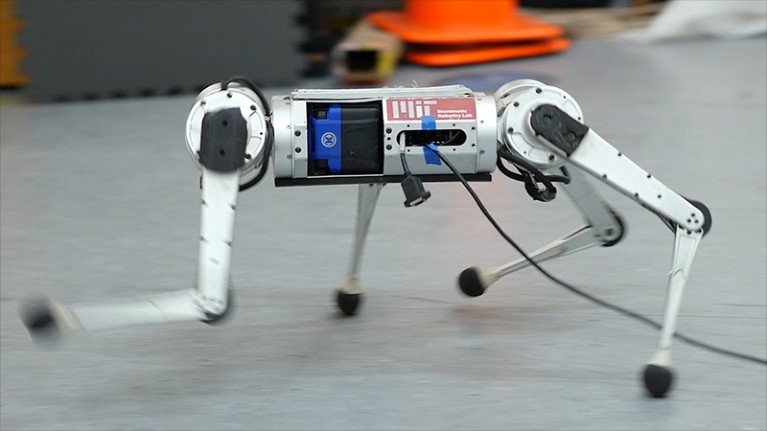
The Mini Cheetah, developed at the Massachusetts Institute of Technology, can run at speeds of up to 3.9 metres per second.Credit: MIT CSAIL
Inspiration can come from anywhere. For Radhika Nagpal, it came from her honeymoon.
Nagpal was snorkelling in the Bahamas when she was approached by a school of colourful striped fish, moving as one. “They come straight at you and check you out and then move off,” says Nagpal, now a mechanical engineer at Princeton University in New Jersey. “I was like, ‘Wow, that is a collective behaviour that I’ve never seen.’”
Part of Nature Outlook: Robotics and artificial intelligence
Her mind returned to those curious fish years later, when she was pondering ways to build swarms of robots that could coordinate their behaviour in challenging environments. The result is a school of robotic fish — called Bluebots — that can coordinate their activity with their fellows1.
Nagpal’s school is small, only ten fish with limited abilities. The fish are equipped with blue LEDs so that their comrades can spot them underwater. Simple rules in their programming, such as swimming to the left when they see another Bluebot, enable them to synchronize their movement. But Nagpal hopes to eventually build larger collectives with more complex behaviours.
Such robotic schools could be tasked with locating and recording data on coral reefs to help researchers to study the reefs’ health over time. Just as living fish in a school might engage in different behaviours simultaneously — some mating, some caring for young, others finding food — but suddenly move as one when a predator approaches, robotic fish would have to perform individual tasks while communicating to each other when it’s time to do something different.
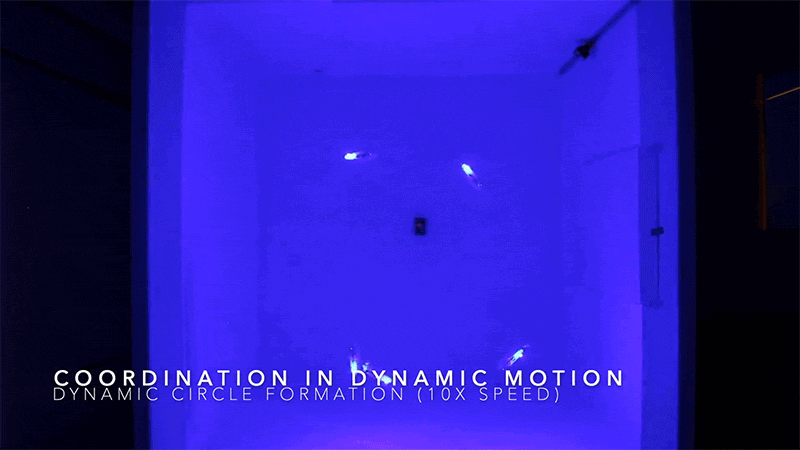
These Bluebots, modelled after schools of fish, can synchronize their movement with each other.Credit: Berlinger, F. et al. Sci. Robot. 6, eabd8668 (2021)
“The majority of what my lab really looks at is the coordination techniques — what kinds of algorithms have evolved in nature to make systems work well together?” she says.
Many roboticists are looking to biology for inspiration in robot design, particularly in the area of locomotion. Although big industrial robots in vehicle factories, for instance, remain anchored in place, other robots will be more useful if they can move through the world, performing different tasks and coordinating their behaviour.
Some robots can already move on wheels, but wheeled robots cannot climb stairs and are stymied by rough or shifting terrain, such as sand or gravel. By borrowing movement strategies from nature — walking, crawling, swimming, slithering, flying or leaping — robots could gain new functionality. They might perform search-and-rescue operations after an earthquake, or explore caves that are too small or unstable for people to venture into. They could carry out underwater inspections of ships and bridges. And unmanned aerial vehicles (UAVs) could fly more efficiently and better handle turbulence.
“The basic idea is looking to nature to see how things can potentially be done differently, how we can improve our automated systems,” says Michael Tolley, a mechanical engineer who heads the Bioinspired Robotics and Design Lab at the University of California, San Diego.
See Spot run
Perhaps the most obvious strategy for robotic motion is walking, and legged robots do exist. Spot, a low-slung, four-legged machine that looks like a headless yellow dog, can climb uphill and navigate stairs. Its developer, Boston Dynamics in Waltham, Massachusetts, markets the US$74,500 device for mobile inspection of factories, construction sites and hazardous environments. A similar-looking robot, the Mini Cheetah, has been developed at the Massachusetts Institute of Technology (MIT) in Cambridge. “More than 90% of land animals are quadruped,” says Sangbae Kim, a mechanical engineer at MIT who helped to design the Mini Cheetah. “So a natural place to look at is the quadrupedal world. And the cheetah is a king of that world in terms of the speed.”
Sign up for Nature’s newsletter on robotics and AI
The Mini Cheetah can already perform backflips, and it runs as fast as 3.9 metres per second — about one-tenth as fast as an actual cheetah, but speedy for a robot. Now Kim is developing control software that he hopes will allow the robot to move smoothly across varying surfaces. This is challenging because the rules for how best to move a limb vary depending on the friction and hardness of the surface. Currently, moving from grass to concrete, or running up a gravelly hill, can cause the robot to stumble. “It runs really ugly and awkward,” Kim says. “It doesn’t fall, but it’s not efficient.”
Nevertheless, quadruped robots are one of the better options for negotiating difficult terrain, says J. Sean Humbert, a mechanical engineer who directs the Bio-Inspired Perception and Robotics Laboratory at the University of Colorado, Boulder. Last year, his group took part in the US Defense Advanced Research Projects Agency’s Subterranean Challenge, in which robots were tasked with navigating tunnels, caves and urban settings to find particular targets; the team took third place, winning $500,000. “The robots that ended up doing really well across the teams were the legged robots,” Humbert says. But faced with a sandy, uphill, rocky landscape, these robots struggled. “Even our Spot robot tipped over and slid around,” he says.
Feel the strain
One possible solution, Humbert says, is to endow robots with animals’ innate ability to sense and respond to mechanosensory information, such as pressure, strain or vibration. He’s been taking that approach with flying machines by embedding strain sensors in the wings of fixed-wing UAVs, as well as in the arms of quadrotor drones, which rely on spinning blades to fly and hover.
The work grew out of studies of honey bees. When Humbert placed bees in a wind tunnel and hit them with sudden gusts of air, their flight would be momentarily disturbed. After a quick change in the pattern of their wing beats, they would right themselves. Honey bees beat their wings 251 times per second, and the animals could make these corrections in just 15 to 20 beats — about 0.08 seconds. “Our conclusion was that [that] had to be mechanosensory information,” Humbert says. “Vision is just not fast enough to correct the spins that we’re seeing.” If a drone could similarly sense a disturbance and automatically correct for it that rapidly, he says, it would be much less likely to crash or be knocked off course.

Some researchers are turning to bees as inspiration for robots that can respond to mechanosensory information.Credit: Sumiko Scott/Getty
Fish also respond to mechanosensory stimuli, using a system of sensory organs known as the lateral line. The structure consists of hundreds of tiny sensors spread along the head, trunk and tail fin, and it enables fish to sense changes in the motion and pressure of water caused by obstacles, such as rocks and other animals. “Fish are sensing all of that and are using that, as well as vision, to position themselves relative to each other,” Nagpal says. No comparable underwater pressure sensor exists, but her team hopes to develop one to improve the Bluebots’ navigation.
In San Diego, Tolley is exploring robots built from polymers or other pliable materials that can more safely interact with humans or squeeze through tight spaces. Squishy, pliable robots could have more flexible motion than hard robots with only a few joints, but getting them to walk on soft legs is a challenge.
Tolley designed a robot with four soft legs, each divided into three chambers2. Pressurized air first enters one chamber, then moves to the next. This movement causes the legs to bend, then relax. By alternatively activating opposing pairs of legs, the robot trundles along like a turtle. And because it does not need electronic controls, its design could be useful even in the presence of electromagnetic interference.
Hard or soft, one issue robots struggle with is falling over. If a multimillion-dollar robot trips over a rock on Mars, an entire mission could be jeopardized. Some researchers are looking to insects for solutions, particularly click beetles, which can jump up to 20 times their body length without using their legs3.
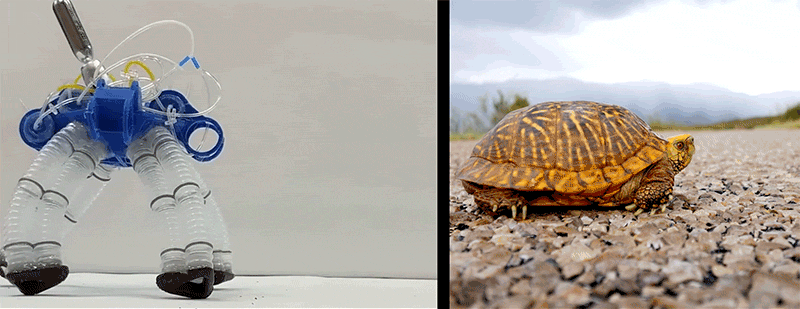
The gait of this soft-legged robot, propelled by pressurized air, resembles that of a turtle.Credit: Left: David Baillot/UCSD. Drotman et al., Sci. Robot. 6. eaay2627 (2021); right: Voshadhi/Getty
Click beetles use a muscle to compress soft tissue, building up energy; a latch system holds the compressed tissue in place. When the animal releases the latch, producing its characteristic clicking sound, the tissue expands rapidly and the beetle is launched into the air, accelerating at about 530 times the force of gravity. (By comparison, a rider on a roller coaster typically experiences about four times the force of gravity.) If a robot could do that, it would have a mechanism for righting itself after tipping over, says Aimy Wissa, a mechanical and aerospace engineer who runs the Bio-inspired Adaptive Morphology Lab at Princeton.
Even more interesting, Wissa says, is that the beetle can perform this manoeuvre four or five times in rapid succession, without suffering any apparent damage. She’s trying to develop models that explain how the energy is rapidly dissipated without harming the insect, which could prove useful in applications involving rapid acceleration and deceleration, such as bulletproof vests. Other creatures also store and release energy to trigger rapid motion, including fruit-fly larvae and Venus flytraps (Dionaea muscipula), and understanding how they do so could lead to more-responsive artificial muscles, Tolley says.
Totally legless
In some places, such as narrow underground passages or on unstable surfaces, legs could require too much space or be too unstable to propel a robot. Howie Choset, a computer scientist at the Robotics Institute of Carnegie Mellon University in Pittsburgh, Pennsylvania, builds snake-like robots with 16 joints that provide a range of motion that could drive everything from surgical instruments wending through the body to reconnaissance robots exploring archaeological sites.
In one early project, Choset took his robo-snakes to the Red Sea, where ancient Egyptians had dug caves to store boats that they’d built for trade with the Land of Punt, thought to be located in modern Somalia. The caves were no longer safe for human explorers, but snake robots seemed well suited to the task — until they didn’t. “The truth is, we got stuck,” Choset says. “We couldn’t go up and down the sandy inclines.”
To work out how a real snake would approach the problem, Choset looked to sidewinders, snakes that move by thrusting their bodies sideways in an S-shaped curve, gliding easily over sand4. Because sand is granular, it can behave as either a liquid or a solid, depending on how much force is applied. Choset found that sidewinders can exert the right amount of pushing force so that the sand remains solid underneath them and supports their bodies. “It wasn’t until we started looking at the real snakes, the sidewinders, and how they moved on sandy terrains that we were able to understand how to make our robot work on sandy terrains,” he says.
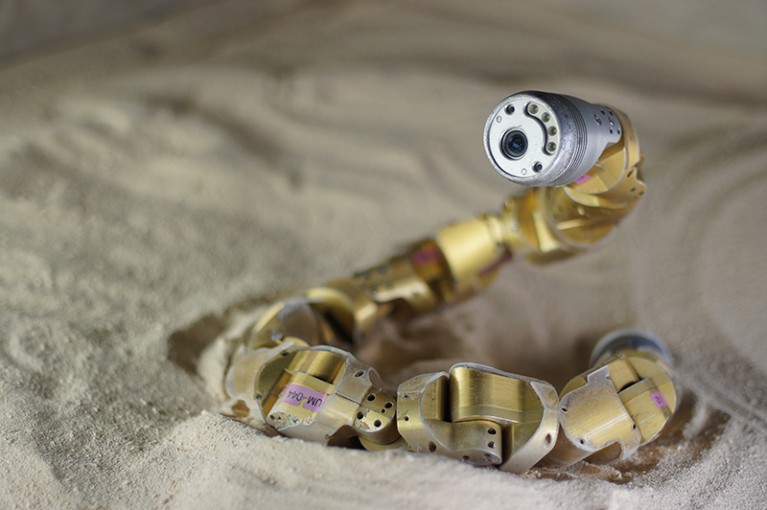
This robot, inspired by sidewinding snakes, moves by twisting in an S-shaped curve.Credit: Carnegie Mellon Univ.
As for Wissa, she’s trying to build robots that can both swim and fly, using an animal that can do both as inspiration: flying fish5. These creatures use their pelvic fins to skim across the water’s surface and then launch into the air, where they can glide up to 400 metres.
Flying fish, Wissa explains, are “actually very good gliders”. But when they drop back to the water, they don’t submerge. “They actually just dip their caudal fin and they flap it vigorously, and then they can take off again,” Wissa says. “You can think of it as a taxiing manoeuvre.” She hopes to learn enough about this behaviour to develop a robot that can move through both air and water using the same propulsion mechanisms. “We’re very good as engineers in designing things for a single function,” Wissa says. “Where nature really can teach us a lot of lessons is this concept of multi-functionality.”
For another type of multi-functional locomotion, Wissa focuses on grasshoppers, which can jump and then open their wings to glide. She hopes to understand what makes them such good gliders. Many other insects rely on high-frequency flapping to fly. Perhaps, she says, it has to do with their wing shape.
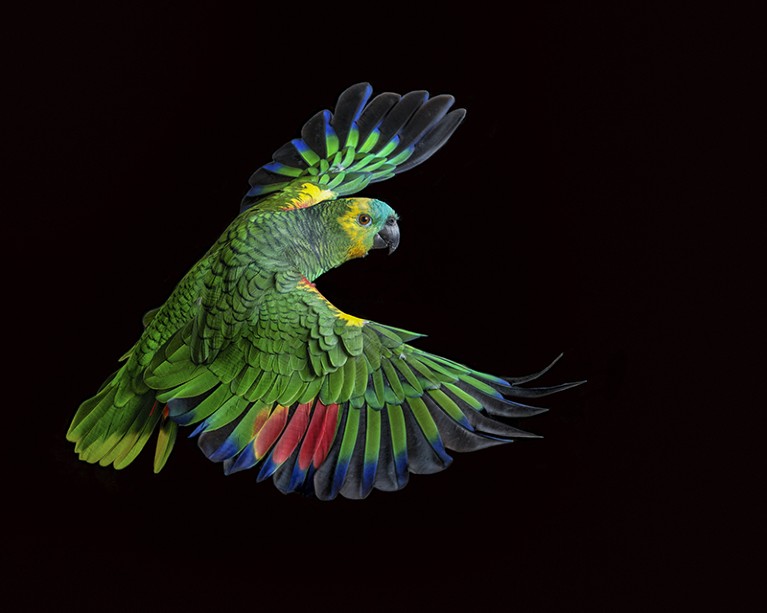
Birds have covert feathers that improve their control over how air flow interacts with their wings. By understanding these feathers, scientists could improve the flight of aerial vehicles.Credit: Barbara Brady-Smith/Tetra/Getty
Wissa also seeks inspiration from birds. She’s used aerodynamic testing and structural modelling to investigate covert feathers — small, stiff feathers that overlap other feathers on a bird’s wings and tail6. When a bird tries to land in windy conditions, the covert feathers on the wings deploy, either passively in response to air flow or actively under control of a tendon. The covert feathers alter the shape of the wing and give the bird finer control over its interaction with air flow, and don’t require as much energy as flapping the whole wing. By learning to understand the physics of these feathers, Wissa hopes to improve the flight of a UAV.
A two-way street
Biology has informed robotics, but the engineering involved can also provide insights into animal kinesiology. “We didn’t start by looking at biology,” Choset says. Instead, he mathematically modelled the fundamental principles of the motion he was interested in. “And in doing so, something kind of magical happened — we started coming up with ways to explain how biology works. So, is it robot-inspired biology or biologically inspired robots?”
More from Nature Outlooks
Other engineers have had similar experiences. Nagpal is collaborating with ichthyologist George Lauder at Harvard University in Cambridge to model the hydrodynamics of schooling, to see whether the formation provides living fish with an energy benefit. And designs that make drones fly in a more energy-efficient way might help to explain how birds and insects have evolved to do something similar. Wissa hopes her work, in addition to building flying, swimming robots, will lead to a greater understanding of flying fish. “We’re using this model to actually test hypotheses about nature, about why some species of flying fish have enlarged pelvic fins while others don’t,” Wissa says.
But despite the links between biology and engineering, don’t expect bio-inspired robots to ultimately look like the creatures that influenced them. Wissa says that, although many first attempts at mimicking biology resemble the original biological forms, scientists’ ultimate aim is to understand the principles behind how the systems operate, and then adapt those to different structures and materials. “We’re just copying the physics and the rules for how things work,” she says, “and then making engineering systems that serve the same function.”




